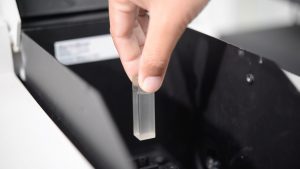If you know a little about spectroscopy, you might know that some types of spectroscopy are known as “absorption spectroscopy.”
You also might know that in absorption spectroscopy, the chemical composition of a sample is determined based on how much electromagnetic radiation within a certain spectrum it absorbs.
But how exactly does this measurement work? Just like with almost every element of the spectroscopic method, there is a certain physics phenomenon that governs this measurement process.
This phenomenon is known as the Beer-Lambert law or Beer’s law for short.
In this article, we will explain precisely what this law is and how it works. We will explain the key attributes that Beer’s law measures (and how it measures them), cover the limitations, and explore how it works in spectroscopy.
Optimize Your Manufacturing Processes with Spectroscopy. Get in Touch
What Is Beer’s Law?
Beer’s law, more formally known as the Beer-Lambert law, defines the attenuation (or absorption) of light by a substance in relation to the chemical properties of that substance.
In simpler terms, the Beer-Lambert law measures how much light a substance can absorb (A) based on three factors:
- Molar attenuation coefficient (ϵ), unique to each chemical element, which determines how strongly the substance absorbs light
- Molar concentration (c) of the substance
- Optical path length (l) of the light beam — the distance that it travels through the substance (measured in centimeters)
As such, Beer’s law is usually expressed in the following formula:
? = ??? A = ?lc
Absorbance vs. Transmittance: How Does the Beer-Lambert Law Measure Them?
As counterintuitive as it may seem, the Beer-Lambert law and its capability to determine the absorbance of a substance is actually derived from the transmittance through a sample.
Before we explain how, allow us to get all the background theory out of the way and define the two variables:
Absorbance is a measure of how much electromagnetic radiation (such as the electromagnetic energy of photons) is absorbed by matter (or by its electrons, more specifically), as the radiation passes through it.
When the matter absorbs the radiation and its energy, both the matter and the radiation may go through certain changes. For example, the electrons within matter may change their vibrational mode and become “excited.” Meanwhile, the radiation itself loses intensity, because it transfers some of its electromagnetic energy to the matter as it passes through it — a process that’s known as attenuation.
The exact kind of transmittance that the Beer-Lambert law measures is internal transmittance — the loss of electromagnetic radiation’s energy by absorbance as that radiation passes through a medium.
In other words, absorbance and transmittance are two sides of the same coin — the difference in energy of an electromagnetic radiation beam as it passes through a certain substance.
Because absorbance and transmittance as properties of matter are so closely related, one can be easily derived from another. Let’s start with transmittance, which is typically expressed as the ratio of:
- Transmitted intensity (I): the intensity of radiation that managed to pass though the substance
- Incident intensity (I0 ): the intensity of radiation prior to the light traveling through the medium
The formula for calculating transmittance goes as follows:
?=??0T=II0
While this ratio typically takes a value between 1 and 0, where 1 denotes full transmission of radiation, it is commonly expressed as a percentage. And once you express transmittance as a percentage, that’s where things get interesting.
We won’t dive too deep into the theory here. However, what expressing transmittance as a percentage tells you is that absorbance and transmittance have a logarithmic relationship.
Expressed as an equation, the relationship goes like this:
?= log10??0A= log10II0
If we simplify it by solving the transmittance ratio, here is the relationship we get:
?= –log10?A= –log10T
In practical terms, a substance that features 100% transmission has an absorbance of 0, as it transmits all of the radiation and absorbs none of it. Meanwhile, 10% transmission translates to an absorbance of 1 — and so on.

Limitations of the Beer-Lambert Law
Even though Beer’s law and the logic behind it can help accurately measure the transmittance and absorbance of a substance (which, in turn, can help determine the chemical composition of the substance), it has several limitations when applied practically:
- Scattering of light in the substance, whether caused by contamination with certain particles or simply by the substance’s nature, essentially renders the law ineffective, as it prevents an accurate measurement of the substance’s transmittance and absorbance capabilities
- Extremely high concentration of the substance can render the Beer-Lambert law equally ineffective, as the inherent electrostatic interaction between the molecules of the substance may cause the absorption and transmission coefficients to deviate
- Non-monochromatic radiation (that is, not isolated within a certain portion of the electromagnetic spectrum) cannot present an accurate measurement of the substance absorbance, as it varies from wavelength to wavelength
- Stray light interrupting the electromagnetic radiation passes through the sample can cause gross inaccuracies in the measurements
- Fluorescent or phosphorescent materials cannot be measured in accordance with the law, as the natural light that they emit will interrupt the electromagnetic radiation used in the measurements.
Configure the right spectrophotometer for your next chemical analysis. Get in Touch
How Does Beer’s Law Work in Spectroscopy?
When applied to a type of absorption spectroscopy, whether Ultraviolet-visible (UV-Vis) spectroscopy or near-infrared (NIR) spectroscopy, the Beer-Lambert law actually functions in reverse.
That’s because the purpose of a spectrometer is, ultimately, not to find the absorbance coefficient of a substance, but rather the chemical composition of that substance. As such, even though spectrometers do measure a sample’s absorbance, they only do that to help establish the variables that make up the absorbance, as per the Beer-Lambert equation:
? = ??? A = ?lc
In a spectrometer, one of these variables— the optical path length (l) of the light beam — actually becomes a constant, because the length that the light will travel is already predetermined by the dimensions of the spectrometer’s test chamber or cuvette in which the sample is placed.
As a result, a spectrometer can determine the sample’s absorbance, which then can be divided by the optical path length to calculate the final two pieces of the puzzle — the substance’s molar concentration and molar attenuation coefficient.
As we’ve mentioned above, each chemical element has a unique molar attenuation coefficient at specific electromagnetic radiation wavelengths. So, if the spectrometer “knows” what chemical element it’s looking for in the sample, it can easily calculate the concentration of that element in the sample that’s being analyzed.
A great example is a caffeine: let’s say you need to determine the concentration of caffeine in a certain solution — such as a beverage.
Caffeine’s absorption spectrum (the electromagnetic spectrum at which its absorbance (A) is roughly equal to 1) ranges from 243–302nm, with pure caffeine reaching its full absorbance at precisely 273nm. Meanwhile, its molar attenuation coefficient (ϵ) is around 9.74×103 M-1 • cm-1.
Plugging these figures into the Beer-Lambert equation, together with the pre-determined optical path length (l), allows you (or rather, the spectrometer) to calculate the precise molar concentration (c) of pure caffeine in your test sample.
Similarly, if you’re not dealing with pure caffeine, you can still determine its concentration in the sample by observing the absorbance of the sample.
For example, based on the Beer-Lambert equation and caffeine’s molar attenuation coefficient (ϵ), a caffeine solution featuring an absorbance of 0.046 translates to a molar concentration (c) of around 5nM. Meanwhile, observing an absorbance coefficient of 0.88 means that the concentration of caffeine in the solution is around 100nM.

Wrapping Up on Beer’s Law
Beer’s law, also known as the Beer-Lambert law, describes the phenomenon that is at the foundation of absorption spectroscopy — a chemical analysis method that can determine the chemical composition of a sample based on its absorbance of electromagnetic radiation.
And even though the Beer-Lambert law is defined as measuring a substance’s absorbance of electromagnetic radiation, it’s actually used somewhat in reverse in absorbance spectroscopy. Because the absorbance of chemical elements at specific wavelengths is usually known, the Beer-Lambert law is applied to determine the concentration (or presence) of a certain element in a solution.
tec5USA offers several comprehensive absorption spectroscopy solutions that are powered by Beer’s law, including UV-Vis spectrometers and NIR spectrometers. Explore our selection and find the right tool for your next chemical analysis.




